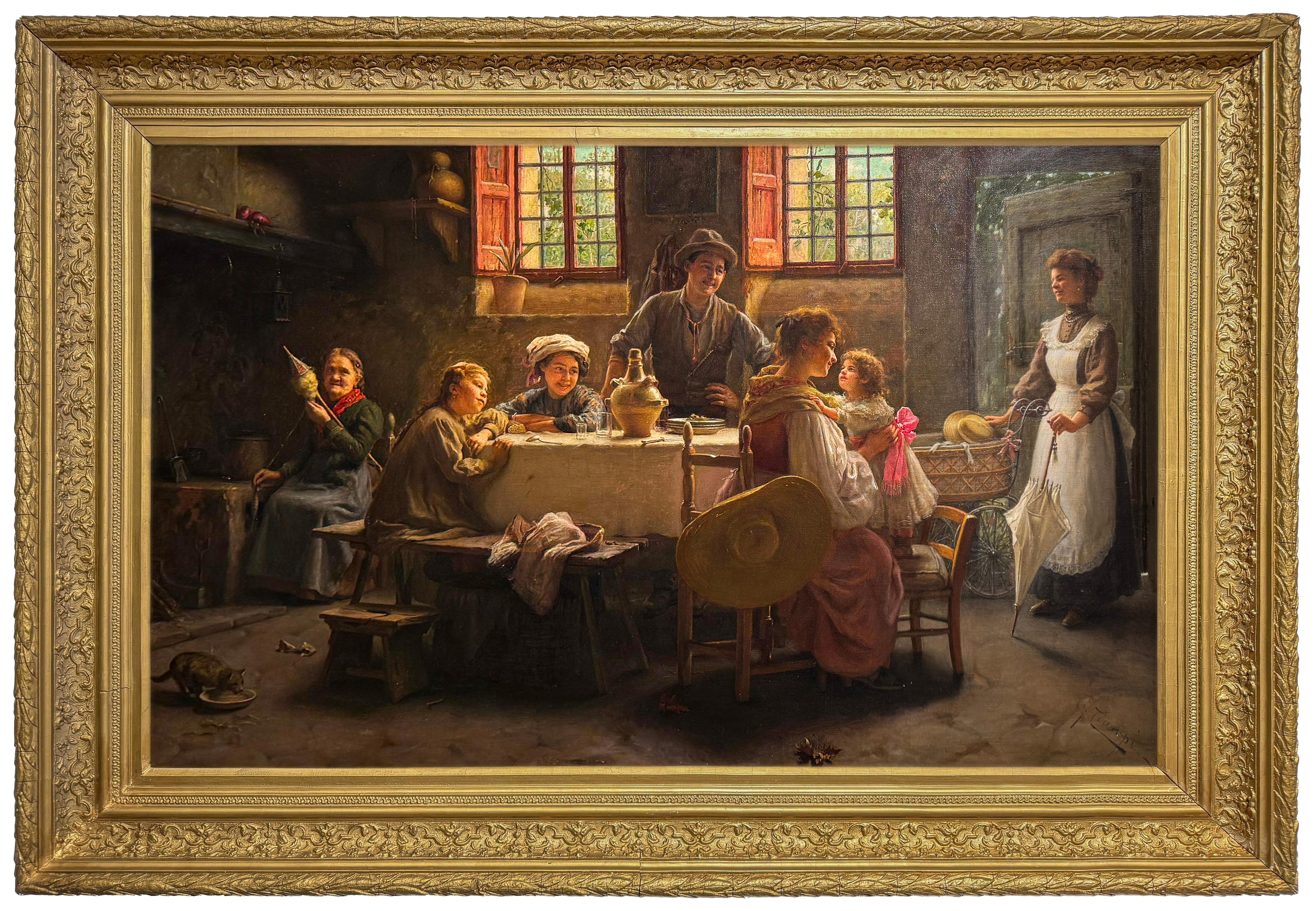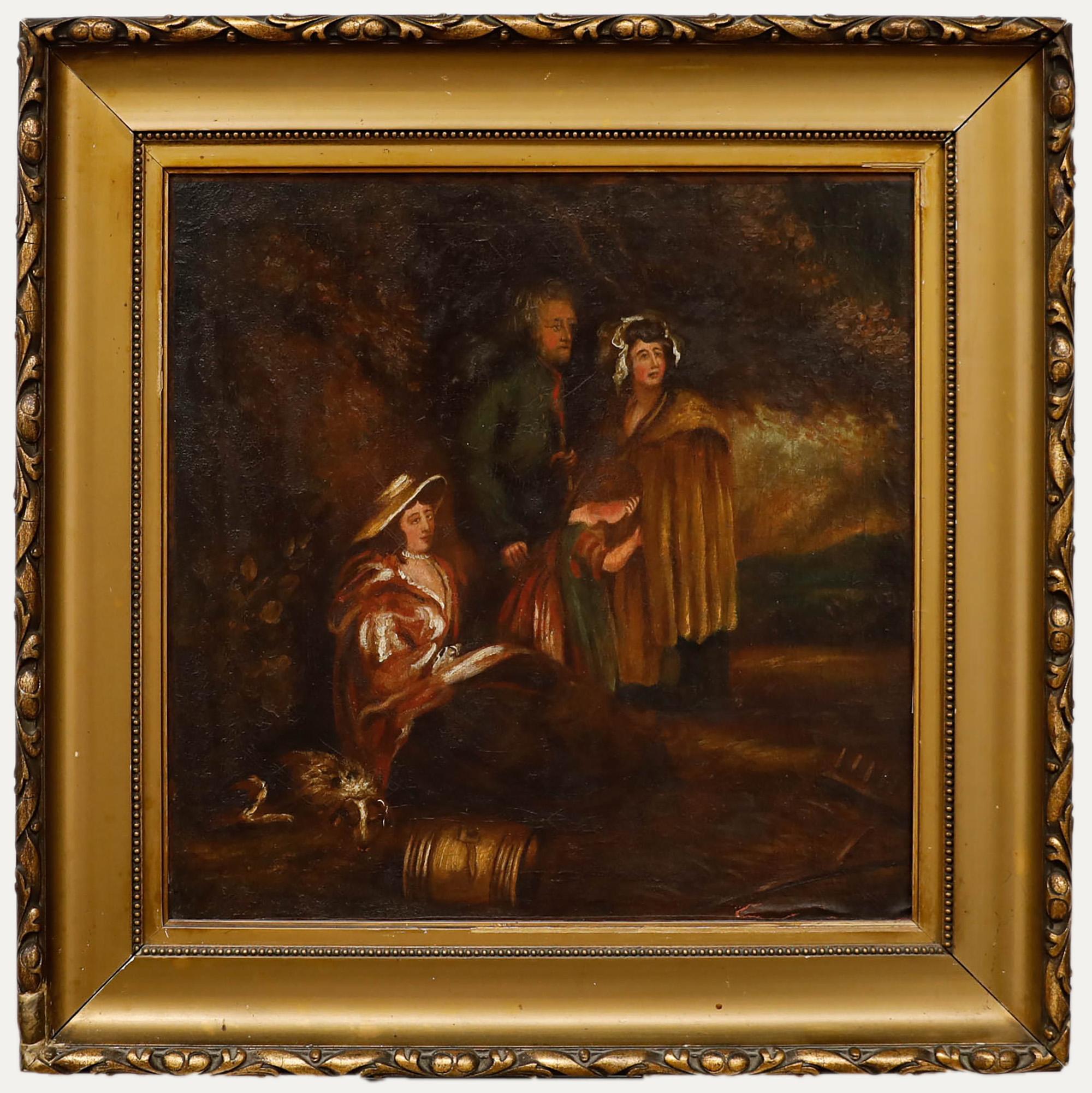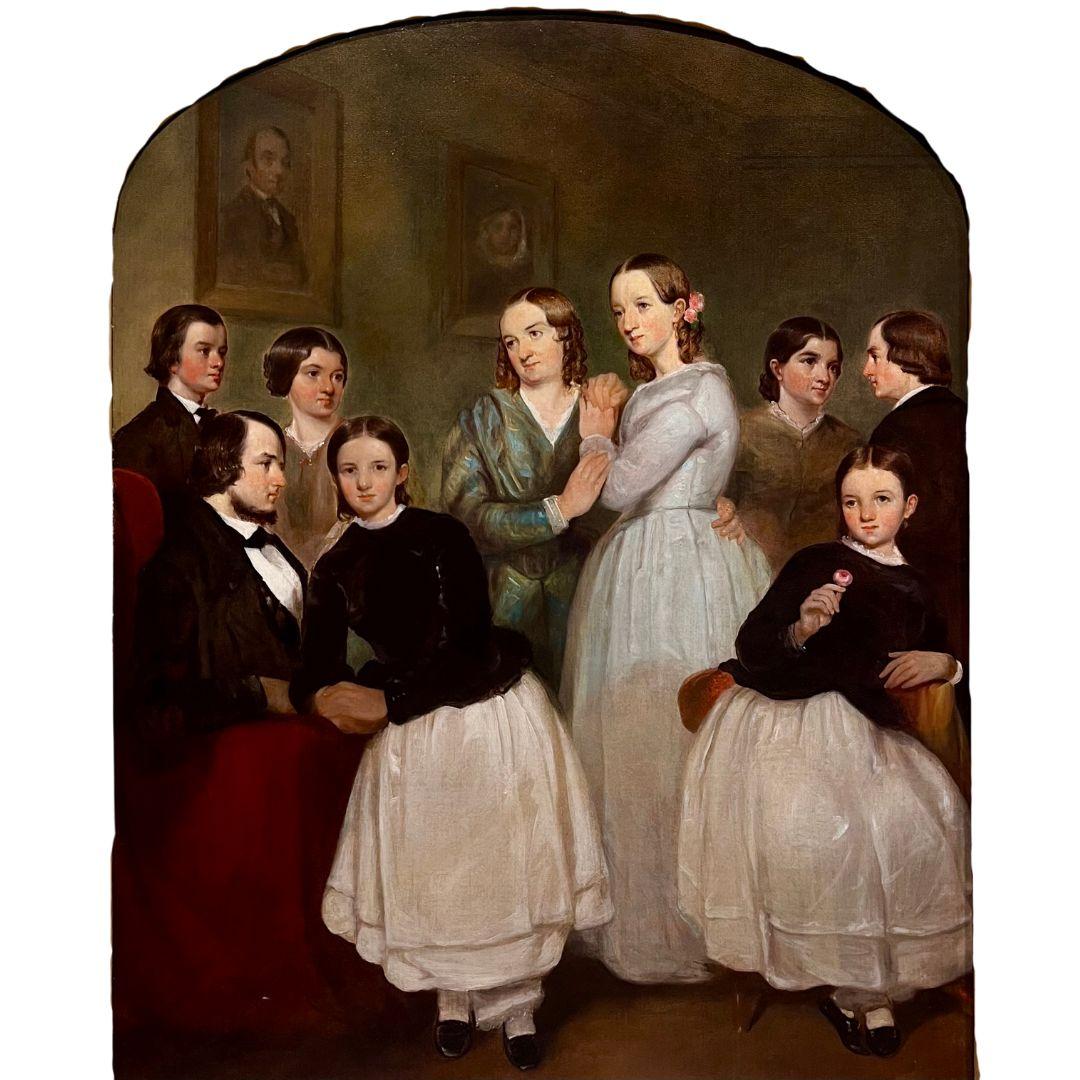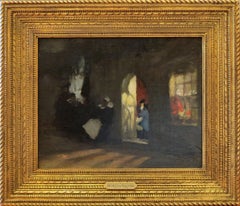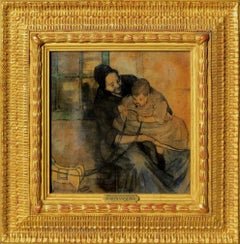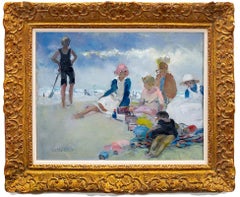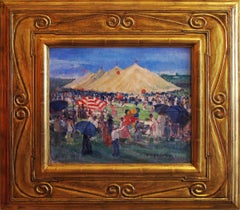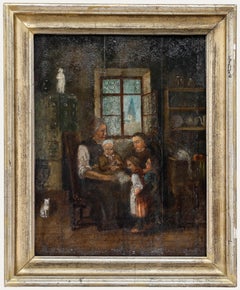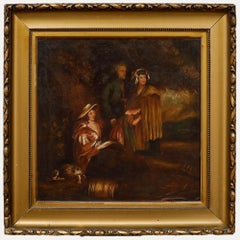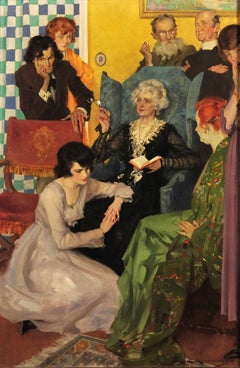Items Similar to "The Brittany Family"
Want more images or videos?
Request additional images or videos from the seller
1 of 6
Martha Walter"The Brittany Family"
$281,250
£213,616.31
€245,697.82
CA$392,961.38
A$438,196.40
CHF 228,632.20
MX$5,376,835.01
NOK 2,910,123.69
SEK 2,757,278.98
DKK 1,833,733.69
Shipping
Retrieving quote...The 1stDibs Promise:
Authenticity Guarantee,
Money-Back Guarantee,
24-Hour Cancellation
About the Item
Jim's of Lambertville Fine Art Gallery is proud to present this piece by Martha Walter (1875 - 1976).
Born in Philadelphia in 1875, Martha Walter attended Girls’ High School followed by the Pennsylvania Academy of the Fine Arts. It was at the Academy that Walter’s artistic talent was discovered. An admiring instructor by the name of William Merritt Chase took young Martha under his wing, giving her both inspiration and direction. She additionally enrolled with Chase at his summer school in Shinnecock, Long Island and in 1903, was awarded the Cresson Traveling Scholarship by the Pennsylvania Academy. This sent Martha Walter on travels to France, Italy, Spain, and Holland, where she attended the Grand Chaumiere and the Academie Julian in Paris. Afterwards, she established a studio on the Rue De Bagneaux in France with several other American women artists. In 1909, Walter won the Mary Smith Prize from the Academy for a portrait she had painted while in Europe. At the onset of World War I, Martha returned home and began painting plein-air subjects, such as Ellis Island, the fishing village of Gloucester, scenes of cheerful children, and the quintessential American beach scenes which have brought her national acclaim.
Throughout her life, Walter continued to travel with great regularity capturing in oil and watercolor a wealth of landscapes and cultures across the globe. Martha lived a charmed life, keeping addresses in New York City, suburban Philadelphia, and Gloucester, while frequently traveling abroad. In her later years she became reclusive, not wanting to be disturbed by galleries and museums. After 1945, Martha spent most of her time in Huntingdon Valley and Glenside, Pennsylvania, where she enjoyed painting flowers from her garden. She never married and lived to the age of 101.
Martha Walter exhibited widely throughout her career, both nationally as well as internationally, and was the recipient of many prestigious awards.
Her work is in the collections of the Pennsylvania Academy of the Fine Arts, the Terra Museum, the Woodmere Art Museum, the Cheekwood Museum in Tennessee, the Toledo Museum of Art, the Art Institute of Chicago, the Detroit Institute of Art, the Milwaukee Art Center, the Musée d’ Orsay and the Musée Du Luxembourg in Paris, among others.
- Creator:Martha Walter (1875-1976, American)
- Dimensions:Height: 32 in (81.28 cm)Width: 40 in (101.6 cm)
- Medium:
- Period:
- Condition:
- Gallery Location:Lambertville, NJ
- Reference Number:Seller: PB01201stDibs: LU37412333702
Martha Walter
Walter was born in Philadelphia in 1875. She enrolled at the Pennsylvania Academy of the Fine Arts, where she studied under William Merritt Chase, who became her primary mentor. At his insistence, she entered a number of Academy student competitions and eventually won a prestigious Cresson Traveling Scholarship in 1908. This award enabled her to travel throughout Europe, where she continued her art education at the Grande Julien in Paris. Soon disenchanted with the academicism of the Parisian schools, Walter set out on her own and began producing plein-air paintings in the manner of the French Impressionists. At the outbreak of World War I, she returned to the United States and took up painting at various East coast beach resorts such as Coney Island and Gloucester. In her beach scenes of this period, colorful bathing suits, gowns and umbrellas punctuate a tranquil, pastel surface. Her expertise in the treatment of light and shadow is evident in her depictions of these settings at various times of day.
In 1922, she spent some months painting the thousands of immigrants kept in the detention hall at Ellis Island. The dreadful, crowded conditions inspired a group of paintings that were exhibited that year in the Galerie Georges Petit in Paris. One was selected for the permanent collection of the Musée de Luxembourg. An exhibition at the Art Club of Chicago in 1941 featured a group of watercolor paintings inspired by the artist's travels through Spain and North Africa. These works were intensely colored visions of such subjects as Algerian street scenes, mosques and Spanish fishermen.
Walter worked well into her nineties, continuing to paint portraits of women and children, beach scenes, gardens and marketplaces. Before her death in 1976, she had exhibited widely, and her works are included in major national and international private and public collections. Hammer Galleries had several exhibitions of her work during her lifetime, the last taking place in 1975 when the artist was one hundred years old.
About the Seller
5.0
Vetted Professional Seller
Every seller passes strict standards for authenticity and reliability
Established in 1997
1stDibs seller since 2014
38 sales on 1stDibs
- ShippingRetrieving quote...Shipping from: Lambertville, NJ
- Return Policy
Authenticity Guarantee
In the unlikely event there’s an issue with an item’s authenticity, contact us within 1 year for a full refund. DetailsMoney-Back Guarantee
If your item is not as described, is damaged in transit, or does not arrive, contact us within 7 days for a full refund. Details24-Hour Cancellation
You have a 24-hour grace period in which to reconsider your purchase, with no questions asked.Vetted Professional Sellers
Our world-class sellers must adhere to strict standards for service and quality, maintaining the integrity of our listings.Price-Match Guarantee
If you find that a seller listed the same item for a lower price elsewhere, we’ll match it.Trusted Global Delivery
Our best-in-class carrier network provides specialized shipping options worldwide, including custom delivery.More From This Seller
View All"Congregating Outside the Home, Brittany"
By Martha Walter
Located in Lambertville, NJ
Jim's of Lambertville Fine Art Gallery is proud to present this piece by Martha Walter (1875 - 1976).
Born in Philadelphia in 1875, Martha Walter attended Girls’ High School followed by the Pennsylvania Academy of the Fine Arts. It was at the Academy that Walter’s artistic talent was discovered. An admiring instructor by the name of William Merritt Chase took young Martha under his wing, giving her both inspiration and direction. She additionally enrolled with Chase at his summer school in Shinnecock, Long Island and in 1903, was awarded the Cresson Traveling Scholarship by the Pennsylvania Academy. This sent Martha Walter on travels to France, Italy, Spain, and Holland, where she attended the Grand Chaumiere and the Academie Julian in Paris. Afterwards, she established a studio on the Rue De Bagneaux in France with several other American women artists. In 1909, Walter won the Mary Smith Prize from the Academy for a portrait she had painted while in Europe. At the onset of World War I, Martha returned home and began painting plein-air subjects, such as Ellis Island, the fishing village of Gloucester, scenes of cheerful children, and the quintessential American beach scenes which have brought her national acclaim.
Throughout her life, Walter continued to travel with great regularity capturing in oil and watercolor a wealth of landscapes and cultures across the globe. Martha lived a charmed life...
Category
Early 20th Century Figurative Paintings
Materials
Oil, Board
"A Grandmother's Delight"
By Martha Walter
Located in Lambertville, NJ
Jim’s of Lambertville is proud to offer this artwork by:
Martha Walter (1875-1976)
Born in Philadelphia in 1875, Martha Walter attended Girls’ High School followed by the Pennsylva...
Category
Early 1900s American Impressionist Figurative Drawings and Watercolors
Materials
Paper, Charcoal, Watercolor
"A Day on the Beach"
By Martha Walter
Located in Lambertville, NJ
Jim's of Lambertville Fine Art Gallery is proud to present this piece by Martha Walter (1875-1976).
Born in Philadelphia in 1875, Martha Walter attended Girls’ High School followed by the Pennsylvania Academy of the Fine Arts. It was at the Academy that Walter’s artistic talent was discovered. An admiring instructor by the name of William Merritt Chase took young Martha under his wing, giving her both inspiration and direction. She additionally enrolled with Chase at his summer school in Shinnecock, Long Island and in 1903, was awarded the Cresson Traveling Scholarship by the Pennsylvania Academy. This sent Martha Walter on travels to France, Italy, Spain, and Holland, where she attended the Grand Chaumiere and the Academie Julian in Paris. Afterwards, she established a studio on the Rue De Bagneaux in France with several other American women artists. In 1909, Walter won the Mary Smith Prize from the Academy for a portrait she had painted while in Europe. At the onset of World War I, Martha returned home and began painting plein-air subjects, such as Ellis Island, the fishing village of Gloucester, scenes of cheerful children, and the quintessential American beach scenes which have brought her national acclaim.
Throughout her life, Walter continued to travel with great regularity capturing in oil and watercolor a wealth of landscapes and cultures across the globe. Martha lived a charmed life...
Category
1810s Figurative Paintings
Materials
Oil, Board
"Family Reunion"
By Paulette Victorine J. Van Roekens
Located in Lambertville, NJ
Jim’s of Lambertville is proud to offer this artwork by:
Paulette Van Roekens (1896 - 1988)
Initially trained as a sculptor, Paulette Van Roekens decided to focus on painting after...
Category
21st Century and Contemporary American Impressionist Figurative Paintings
Materials
Canvas, Oil
"Theresa Thompson"
By Gershon Benjamin
Located in Lambertville, NJ
Jim’s of Lambertville is proud to offer this artwork by:
Gershon Benjamin (1899-1985)
An American Modernist of portraits, landscapes, still lives, and the urban scene, Gershon Benj...
Category
1940s Modern Figurative Paintings
Materials
Masonite, Oil
"The Gathering"
By Joseph Barrett
Located in Lambertville, NJ
Jim’s of Lambertville is proud to offer this artwork.
Oil on canvas
Joseph Barrett (b. 1936)
Joseph Barrett was born in Midland, North Carolina, in 1936 and studied at the Massac...
Category
20th Century American Impressionist Landscape Paintings
Materials
Canvas, Oil
You May Also Like
Framed 19th Century Oil - Family Scene
Located in Corsham, GB
A naive yet charming 19th-century study of a small family gathered around a baby. The mother cradles the infant in a chair while a small white cat watches quietly in the background, ...
Category
19th Century Figurative Paintings
Materials
Oil
Italian 20th Century painting of a family time
Located in New York, NY
Giacomo Campi, excellent condition. Oil on canvas 26x42 inches.
Category
Early 20th Century Interior Paintings
Materials
Canvas, Oil
Continental School 19th Century Oil - Peasant Family
Located in Corsham, GB
A charming scene depicting a peasant family and their dog in a landscape. Unsigned. Presented in a gilt frame. On board.
Category
19th Century Figurative Paintings
Materials
Oil
$359 Sale Price
20% Off
Family Escape
By Charles E. Chambers
Located in Fort Washington, PA
Date: 1917
Medium: Oil on Board
Dimensions: 32.00" x 21.00"
Signature: Signed Lower Right
Story illustration: Group of people gathered around seated old woman.
“Isn't it quite as i...
Category
1910s Figurative Paintings
Materials
Oil, Board
Francis William Edmonds Family Portrait
Located in Fredericksburg, VA
In Francis William Edmonds' family portrait, six women and three men are elegantly arranged in a formal yet intimate setting, capturing a moment of togetherness. The composition refl...
Category
Mid-19th Century Figurative Paintings
Materials
Canvas, Oil, Board
W. Smith - 19th Century Oil, Giving Alms
Located in Corsham, GB
This evocative painting depicts a tender scene of maternal care, with a woman in elegant attire standing near three children huddled together. The composition is framed by a richly g...
Category
19th Century Figurative Paintings
Materials
Oil
More Ways To Browse
Walter Paris
Antique Brittany
Pennsylvania Dutch Art
Luxembourg Gardens Paris
Paris Luxembourg Gardens Paintings
Oil Painting Of Pennsylvania Dutch
Jim Holland
Pennsylvania Dutch Antique
Girl Fishing
Billy The Artist
Italian Oil Painting Renaissance
Charles Littler
Christ Oil Painting
Oil Painting Turkish Artists
Painting Seated Man
Rembrandt Oil Painting
Vintage Mexican Woman
Jewish Oil Canvas


